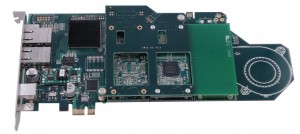Today, Octasic announced the immediate availability of its new range of high density video transcoding cards, the TXP1000.
Octasic has designed the TXP1000 PCI Express (PCIe) plug-in cards to directly offload the host CPUs for high channel density video and voice transcoding applications. The TXP1000 cards use Octasic’s award winning Vocallo MGW (DSPs) Digital Signal Processors and media processing software stack to provide an easy to use and low power (less than 25 Watts) accelerator card in a PCI Express form factor. The company claims that the TXP1000 cards provide the highest transcoding density per watt in the industry using: H.264, MPEG4, H.263 video codecs and G711, G729, AMR voice codecs: A single TXP1000 card easily delivers 335 channels of video transcoding while offering power consumption well within the power budget of a single PCI card.
The TXP1000 cards should enable network service providers and Internet equipment manufacturers to rapidly develop and deploy efficient and high channel density video transcoding systems.
John Fry, director of business development at Octasic Inc. said in today’s press release, “Compared to standard x86 server-based solutions that suffer from serious power, cost and scalability limitations, Octasic’s TXP1000-based systems provide tangible benefits that can cut video transcoding systems capital costs in half, reduce the power consumption by a factor of 8 and still deliver 5 times more channels per unit of rack space. Octasic is unique in that it has the right combination of low power DSP technology, video expertise and communications technology heritage to successfully meet the demands of this growing market.”
TXP1000 cards can be used for any scalable media transcoding, web to mobile, IVVR (Interactive Voice & Video Response) and IP based voice and video telephony gateway systems. The use of an industry recognized form factor and an IP based host API and communications stack, means that TXP1000 cards can be easily added to existing systems to drastically increase channel density and efficiency.
Furthermore, the standard functionality also includes video and voice quality processing features such as video packet loss concealment, scaling, mixing & keying, as well as voice echo cancellation and adaptive noise reduction.
With demand for mobile video on the rise, real-time video transcoding is required to support the myriad of device types, video formats and dynamic bandwidth conditions on the open Internet and mobile networks.






